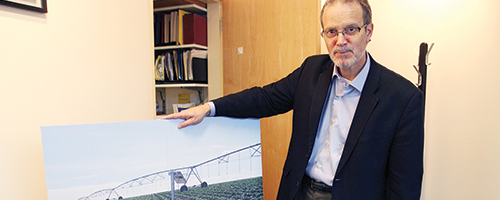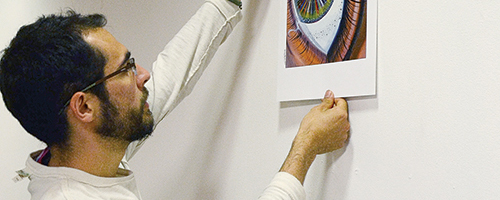Wesley Petersen exposes his nearly naked body to the camera, performing a number of close-up tummy exercises while his arms are positioned spread-eagle. His upper left chest reveals a tattoo of three handprints in blood, done by his wife.
Animalistic art
[portfolio_slideshow id=48397]
Wesley Petersen exposes his nearly naked body to the camera, performing a number of close-up tummy exercises while his arms are positioned spread-eagle. His upper left chest reveals a tattoo of three handprints in blood, done by
his wife.
The tattoos are cavelike and symbolize the love and pain that he and his wife carry for each other. Each splatter of blood represents the pain and scarring that Petersen’s wife endured in childbirth.
Petersen, a visual artist and Portland State student, explores the duality of human and animal and its impact on the narrative of our human existence. On some level, his work proves that, as humans, we all possess animalistic intuitions.
One way he does this is by planting and creating his own artifacts. As time goes by, Petersen will travel back to the location and search for his artifacts. In one instance, he did this with a white mask, which he buried in an Oregon forest.
Petersen holds a bachelor’s degree in sculpture from the University of Idaho and is one of five students enrolled in Portland State’s graduate art program. He works solely from his studio space in the Art Building.
Petersen is a man of many talents, a dedicated family man and father of two. While maintaining a 4.0 grade point average, Petersen takes care of his autistically challenged son, who was diagnosed with joint arthritis at an early age.
“He’s constantly in so much pain, and we have to make so many trips to the hospital,” Petersen said. “It’s no easy thing to watch.”
One of his works, Superhero, was inspired by his son. The black-and-white animated video captures the bravery of a little boy dressed in a superhero cape and mask. He is seen performing a number of repetitive movements while running and bouncing in place.
“This video is about the physical exploration of human beings and how we are able to feel brave for just a few moments,” Petersen said. “It deals with the process of being emotionally connected as humans.”
In his studio, Petersen keeps a compilation of short films, paintings and comic strips, which are pasted on the walls. Petersen explained that, as a child, he used to collect things such as comic books in order to escape a troubled childhood.
“I was a hyper kid living vicariously through my comic book collection,” Petersen said, “and often created a fantasy world inside my head.”
Petersen was diagnosed with attention deficit hyperactivity disorder as a child, and he found it difficult to perform on the same level as the rest of his peers. In high school, his grades suffered tremendously, and he was held back from graduating with his class. His GPA was a whopping 0.8.
Shortly after graduation, Petersen knew he wanted to attend college and turned to physical activity to cope with academics. He began teaching martial arts and jiujitsu, which can be seen in many of his films.
Petersen still keeps in contact with his former students in Idaho, who recently started a jiujitsu club. Although he is currently unable to teach because of his hectic schedule, Petersen still practices.
“Right now, I’m training and fighting for Bristol Marunde, who is a close friend and owns [a fight club based out of Washington called] Reign Promotions,” Petersen said.
With hopes of exploring the physical and emotional movements of our historical past, Petersen continually finds ways to bring this concept into modernity. Ashes come falling is one of Petersen’s most recent works. It’s a four-minute abstract film that looks as though it’s traveling through radioactive sound waves.
Petersen hopes to take a more abstract than literal approach to his art. This is a film that also plays on themes of fighting and aggression.
“To get that deep sound, I ran my guitar through an electrical sound machine while singing only in vowels,” Petersen said.
Supposedly he gravitated toward this style of music because it is the oldest form of language, the basis of all languages.
“We are connected to a visceral human thing,” Petersen explained.
Petersen’s influences stem from ’60s and ’70s artists such as Andy Warhol, whom Petersen has studied extensively. He also admires British artist Angela Carter, who uses an almost animalistic sexuality as power, and refers to her as a “Sadeian Woman.”
Petersen takes a similar approach to his art. He explains Carter’s process as regulating the control over our own biological instincts.
“[Most of us] view humans as being separate, which is totally not the case,” Petersen said. “My work is deeply influenced by my exploration into human evolution and anthropology.”
Petersen’s art often deals with aggression: One of his works is a video of a wrestling match between him and a former student.
“The film investigates a hyper level of aggression that can occur with two males when locked between tight quarters,” Petersen said. “You’re locked in this space, where the other person is metaphorically trying to kill you. I was knocked unconscious while trying to argue a ritual violent act.”
Petersen believes that, as humans, if confined to a tight space with no escape, we let our animalistic behaviors manifest without realizing it.
In the future, he wants to steer away from the obvious while taking a narrative approach to his art. In other words, he experiences more satisfaction as an artist if he can create a level of complexity and interpretation.
“I would like to take my work beyond a gallery level,” Petersen said, “and bring it into reality.”





